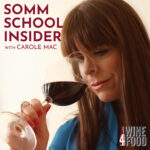 Barolo and Barbaresco are the aristocratic siblings of Piemonte: rich, powerful wines that age with grace and elegance. Like well-heeled guests who are entertaining conversationalists, everyone wants them at their dinner table. Yet, like all siblings, they may share similar DNA and heritage, but they also have distinct personalities.
Barolo and Barbaresco are the aristocratic siblings of Piemonte: rich, powerful wines that age with grace and elegance. Like well-heeled guests who are entertaining conversationalists, everyone wants them at their dinner table. Yet, like all siblings, they may share similar DNA and heritage, but they also have distinct personalities.
Both DOCG wines are made with 100 percent Nebbiolo, an intense, tannic ancient red variety that delivers profound aromas and flavors ranging from roses, violets and licorice to chocolate, tar and leather. The name “Nebbiolo” is derived from the Italian word for “fog,” a nod to the mist that settles on the vineyards winding throughout the Langhe where the two production areas are in designated village territories referred to as “communes.”
Located a few miles southwest of Alba, Barolo is comprised of 11 communes. The steepest hills “above the clouds” in Barolo are where the best vines are located; here the soil is poor which means the vines struggle more, resulting in more powerful fruit. Barbaresco is comprised of three communes northeast of Alba closer to the Tanoro River where the soils are more alluvial and fertile, resulting in grapes with more perfumed fruit. Both are tannic wines with strong personalities; they just charm you in different ways as your put them to your lips.
Envision a firm full-mouthed passionate kiss versus an amorous soft smooth one. Both cover your tongue and deliver quivers of pleasure, and they both leave you desiring more.
 Barolo is considered the more muscular, masculine style, and Barbaresco, softer and feminine. But wine experts all agree it can vary by vineyard, producer and style of wine—traditional or modern. Aging requirements for Barolo are longer, at least 38 months, including 18 in wood barrels and cellared for 5 years from date of harvest; Barbaresco requires a minimum 26 months aging including nine months in wood barrels and cellared two years from date of harvest. Riserva Barolo must be cellared at least five years, and Riserva Barbaresco for four years. Both evolve into complex wines that are best opened after 12 years; many sommeliers say the “sweet spot” is 20.
Barolo is considered the more muscular, masculine style, and Barbaresco, softer and feminine. But wine experts all agree it can vary by vineyard, producer and style of wine—traditional or modern. Aging requirements for Barolo are longer, at least 38 months, including 18 in wood barrels and cellared for 5 years from date of harvest; Barbaresco requires a minimum 26 months aging including nine months in wood barrels and cellared two years from date of harvest. Riserva Barolo must be cellared at least five years, and Riserva Barbaresco for four years. Both evolve into complex wines that are best opened after 12 years; many sommeliers say the “sweet spot” is 20.
I sought out perspectives from wine experts to describe the personalities of these wines. Catherine DiGennaro, Wine Director for Michelin two-star rated Jungsik in Manhattan, said, “Nebbiolo has higher tannic structure in Barolo due to differences in aging. Barolo has more body and mouthfeel being higher in alcohol and tannic structure; it needs more time. Barbaresco has a medium-plus structure with more integrated tannins in a youthful state, depending on the producer’s style. You can open younger bottles and enjoy the freshness without the tannins being overly aggressive.”
Master Sommelier Kyungmoon Kim was opening sommelier at Jungsik, worked at the Modern, and now imports fine Korean spirits. He offered this: “Barbaresco is like a rose with thorns. It’s pretty and elegant but if you get too close, it can sting. Barolo is like an lion locked in the cage. One doesn’t know how to tame it and it will take a long time to do so but every time you open, you realize it will never be controlled.”
East Meets West: Pairing Barolo & Barbaresco with Asian Dishes
Usually traditional pairings focus on what grows together, goes together. For Barolo and Barbaresco, that means Risotto al Barolo, Brasato al Barolo (braised meat in red wine) and Bollito Misto (boiled meats with aromatic herbed dipping sauces). But both pair beautifully beyond the Italian border or with traditional American steak and red wine meals. As they age, Barolo and Barbaresco develop earthy, sultry, mushroomy “umami” characteristics that work well with fattier fish, pork, and beef. To illustrate, we focused on Asian foods with enough fat, smoke and spice to stand up to the tannins:
Waygu beef and Iberico pork: “Both have more marbling which will hold up to the tannic structure of Barolo or Barbaresco, especially the pluma cut (similar to a pork loin) which is a richer, dark cut of pork. Jungsik’s Iberico pork is a reinterpretation of Korean barbecue with caramelized onion, mustard green, pickled crosnes and fermented beltfish from Jeju Island,” offered DiGennaro.
 Fatty fish: cod, salmon and bluefin tuna work well, but consider the spices and condiments and the preparation such as grilling or hearty fish stews. “At Jungsik, our black cod is slow poached in red pepper soy marinade and served with house-made pickle, shishito pepper and chive oil. The hint of sweetness and spice holds up well to a red wine with more body—but just not too tannic—like a more modern Barbaresco from a riper vintage with new oak to soften the tannins,” noted DiGenarro.
Fatty fish: cod, salmon and bluefin tuna work well, but consider the spices and condiments and the preparation such as grilling or hearty fish stews. “At Jungsik, our black cod is slow poached in red pepper soy marinade and served with house-made pickle, shishito pepper and chive oil. The hint of sweetness and spice holds up well to a red wine with more body—but just not too tannic—like a more modern Barbaresco from a riper vintage with new oak to soften the tannins,” noted DiGenarro.
Peking duck: “The acidity and tannic structure of Nebbiolo cut through the richness of the meat and crispy skins. Usually Peking duck is made into a wrap with pancake and additions hoisin sauce and scallions. The umami and slight sweetness of hoisin sauce work great with savory flavor of Nebbiolo, especially a more modern style with riper fruits and rounder tannins to complement the sweetness of the sauce and glaze of the duck.”
What to Drink if You Prefer…
Kyungmoon Kim MS recommends:
Burgundy: “Burgundy drinkers are looking for finesse and elegance with fine nuances coming from expression of single parcel or terroir. I would recommend a Barolo wine by Giovanni Rosso from Serralunga d’Alba.”
Bordeaux: “I would recommend the wine that displays powerful, complex, and firm structure while showcasing potential of long aging. The producer that fits the profile is Giacomo Conterno Monfortino. It is considered the greatest Barolo and I would consider this wine as Chateau Latour of Piemonte.”
Cabernet Sauvignon: “Cabernet Sauvignon drinkers enjoy abundant fruit and great structure in their wine with recognizable names. I would recommend producers such as Roberto Voerzio or Angelo Gaja that shows power and structure while giving supple texture and silky tannin.”
Modern vs Traditional
Another consideration is whether you prefer a traditional style Barolo or Barbaresco that undergoes longer maceration and is aged in large neutral Slavonian oak barrels, producing more austere tannins. Or perhaps you prefer a modern style, with shorter maceration and aged in small new French oak barriques, resulting in a fruitier, slightly oakier style. When selecting a wine to purchase, these are questions to ask your sommelier on wine shop salesperson.
Either way, and with either style, the appreciation of Barolo and Barbaresco always sparks a lively conversation, and they will always be welcome meal companions.
Most of these recommendations from Catherine DiGennaro are all from the 2010 vintage which, according to The Wine Spectator vintage chart, was “a cool growing season and ideal weather before harvest; pure, elegant and structured reds, with fine potential for aging.”
Classic Barolo: Vietti, Marchesi di Barolo
Modern Barolo: Giulia Negri (2013 vintage)
Classic Barbaresco: Marchesi di Grésy
Modern Barbaresco: Gaja
Wine4Food Recommends: Palazzo Schiavino Barolo

Melanie Young co-hosts the national weekly radio show, The Connected Table LIVE! Wednesdays 2 pm EST on W4CY Radio and podcast permanently to iHeart.com and the free iHeart App.



